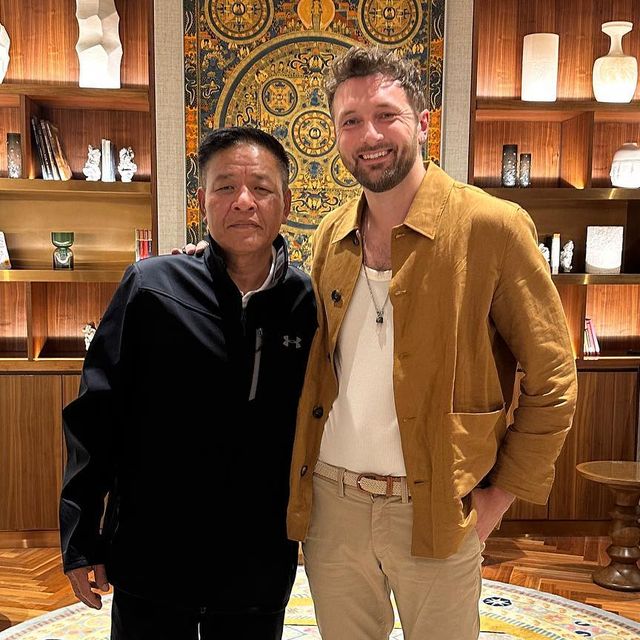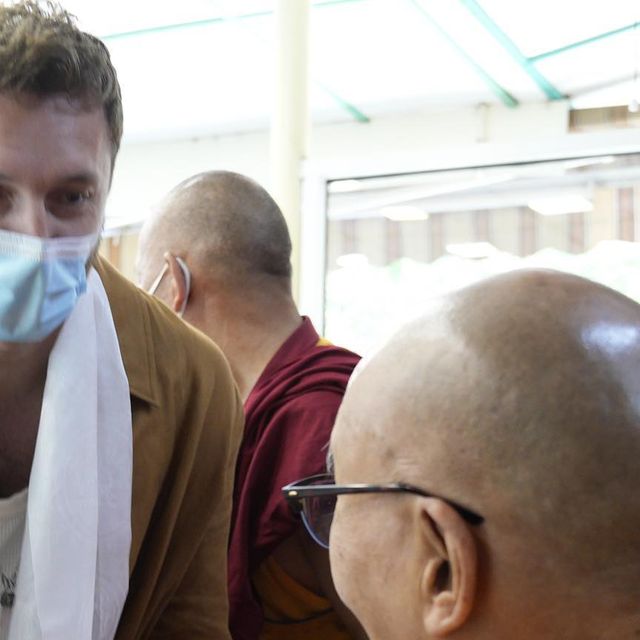What I learnt from meeting the exiled President of Tibet
On our recent trip to India, not only did I have the absolute pleasure of meeting with his holiness the Dalai Lama, but also the second President of Tibet Sikyong Penpa Tsering. Both were profound experiences. Let me tell you a little bit about the insights the exiled president provided me regarding the philosophy of the Middle Way, and how we can all relate it to improving our own daily lives and relationships.
What is Free Tibet?
But first, a little background. At the core of the Free Tibet movement lie fundamental principles of non-violence and a middle ground approach to resolving conflicts with China and reclaiming Tibet. However, it has been nearly sixty years since the spiritual leader and key figure of peaceful resistance, the Dalai Lama, also known as Tenzin Gyatso, the 14th spiritual leader of Tibetan Buddhism, fled from Tibet under the control of China out of fear for his life. Despite the Dalai Lama’s belief, based on dreams, that he will live until the age of 113, the passing decades and shifting global attention to other crises have led experts to suggest that Tibetan Buddhism is now at a pivotal juncture. Assessments made by independent observers indicate that the prospect of returning to Tibet remains highly remote for those who aspire to do so.
 What is the Middle Way?
What is the Middle Way?
Though we often talk about the “road less travelled”, the “middle path” is a concept that is often overlooked when discussing the choices we make in our lives. Derived from Buddhist teachings, this concept emphasizes the importance of finding a balanced approach between two extremes or options. By staying centred and balanced in our decisions and way of being, we strive to achieve a state of equanimity. This teaching has profoundly impacted me throughout my childhood and into adulthood, as I constantly seek to embrace and embody the Middle Path. It is akin to Goldilocks’ quest for the perfect porridge – not too hot, not too cold, but just right. Whenever I encounter emotional or mental turbulence, the Middle Path provides solace and tranquillity during moments of internal turmoil.
The fundamental definition of the Middle Way encompasses various concepts, including moderation, non-bias, non-prejudice, non-discrimination, non-alignment, equality, purity, neutrality, detachment, fairness, firmness, calmness, equanimity, tranquillity, stillness, silence, independence, liberation, emptiness, selflessness, compassion, generosity and enlightenment.
We all possess varying perspectives and conceptions about life to some degree. While these notions can occasionally contribute to the progress of humanity, a predicament arises when we become entrenched in our ideas and perceive them as indisputable truths. When individuals firmly believe in the absolute truth of something, they may become willing to engage in conflict, violence, or even sacrifice their lives for it. Consequently, this mindset fosters polarization, profound divisions, and suffering within ourselves, our society, community, and family. It is evident that this path does not lead humanity towards a prosperous future.
How can we relate it to our own life?
I have come to understand the Middle Way, and therefore, I write based on direct realisation rather than personal opinion, dogma, or belief. I do not believe in false modesty, as it would not be beneficial to a sincere practitioner seeking truth and meaningful discussions.
The Middle Way pertains to Non-duality, which is the perspective that distinct natures are not separate from each other. On the other hand, the viewpoint of separation between the physical and mental is rooted in Duality.
Contrary to popular belief, the middle way is not simply a compromise between two opposites such as pushing and pulling or loving and hating. Pairs of opposites are constructs of the mind and do not accurately represent actual reality. They are merely beliefs of the mind that must be relinquished.
The true Middle Way encompasses what the mind perceives as extremes or opposites. It transcends duality and is completely non-dual. This middle way is neither good nor bad; it is a mysterious state of not knowing whether it is good or bad. Things simply exist as they are.
Objects do not exist in the two extremes of either existing independently from the mind or not existing at all.
Immediately, then, we can learn to avoid the extreme view of any argument. Too often discussions in today’s world take the form of arguing for one extreme against another. The world is not black and white. The truth is always a shade of grey.
Understanding this is all well and good, but we also need to have the self-awareness to understand when we ourselves are on one extreme side of the spectrum. Just because there is someone holding a viewpoint even more extreme than ours, it doesn’t mean we are closer to the truth than a person on the other extreme side of the spectrum.
Continuing your own journey to understanding the Middle Way
Understanding the Middle Way gradually unfolds through the realisation of the three causes of object existence. Each cause becomes progressively more subtle and concealed from the ignorant mind. Objects exist in dependence upon:
- Causes and conditions
- Their constituent parts
- Their designation or name
Most Buddhists agree with the first cause, but only a few have realised the second cause. Based on my own experience of engaging with awakened and enlightened individuals, it is extremely rare to have realised the third cause.
I have provided meditations and teachings on these three causes in my meditation classes. They cover all aspects comprehensively. I personally came to understand each cause gradually through extensive meditation and contemplation. The actual realisation occurs in a single moment. One of the guided meditations focuses on how objects come into existence through causes and conditions, their parts, and their name. This meditation aligns with Nagarjuna’s description of what the Middle Way of existence is.
Reading about these concepts is relatively easy, but engaging in the practice of meditation and contemplation to understand how objects exist in these three ways is much more challenging. It requires patience, time, and genuine realisation. Due to the lack of interest, very few individuals pursue this path, resulting in the rarity of realisations regarding the second and third causes.
The commonly held Buddhist understanding of interdependence aligns with the first cause.
Whoever thoroughly comprehends the Middle Way can progressively and swiftly realise the ultimate reality of oneness and purity.
One who has completely detached their heart from all conditioned phenomena becomes united with the Sanka-oubeka-yanna. By maintaining an equal distance from everything without favouring one over the other, they treat things and beings equally, leading to freedom from the mind of discrimination and internal or external conflicts, interests, or influences. This enables them to return to their original essence of equanimity. This state of equanimity arises because there are no conflicting forces driven by conditioning that would cause something to arise or cease.
In this state, they gain certainty that conditioned phenomena do not originate from within. Since their mind is no longer troubled by objects and concepts, they are certain to embark on an irreversible path and become one with absolute oneness. Without a troubled mind, they can no longer cause any harm to themselves or others, making them perfect in essence. Therefore, it is a false statement to claim that human beings cannot attain perfection. The Buddhist notion of perfection is not expressed through physical or psychological dimensions, but rather through the ultimate spiritual dimension.
If a teacher only imparts this basic initial explanation, students often cling to it as the absolute truth and lose the desire to contemplate further, fearing that it may disrupt their faith in the teacher. The door to further exploration should always remain open, regardless of the teacher or the source of information.
I hope this has in some way demystified the beliefs of the Tibetan Buddhist monks and the Middle Way. With this knowledge now imparted, I hope you can begin your own journey to realising the nature of existence, using it to improve your life.
Don’t miss out next time!
You don’t want to miss out on more opportunities like this. To be amongst the first to get notified about up and coming trips to India, get in touch with us and sign up to our newsletter. Spaces are limited so get in touch now to avoid disappointment!
Can’t travel? No problem! I work with clients all over the world to work through problems such as social anxiety, a lack of confidence and making strong connections that last.
If you want to read more about lifestyle, dating, and a whole host of other topics, check out the wealth of articles on my website.
 What is the Middle Way?
What is the Middle Way?